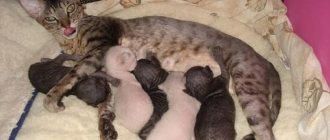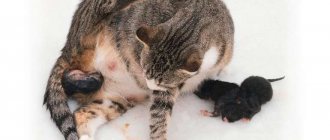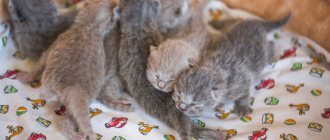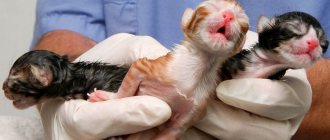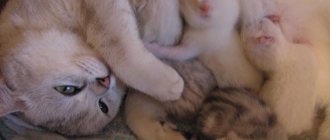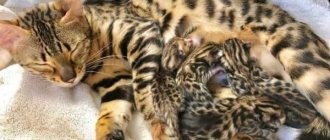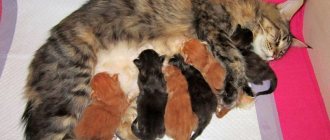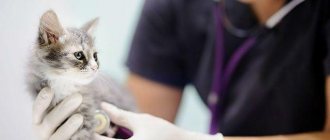The period of pregnancy and childbirth in domestic animals, in this case cats, is a process that occurs in natural conditions, without human intervention.
But there are also exceptions. For example, if a cat has caught an infection, gives birth for the first time, or there are dead kittens in the litter. In such cases, the question “how to help a cat give birth” is natural. Here, of course, you cannot do without the help of the owner and the veterinarian, but how do you understand that the animal needs help and what needs to be done in such cases? Let's figure it out together.
The cat should give birth mainly at home
If a cat’s pregnancy proceeded calmly, smoothly, without complications, then she should give birth without any problems. The main thing is not to be nervous, as the animal easily picks up the mood and vibrations emanating from the owner and also begins to noticeably worry, which can lead to problems during childbirth.
The cat should give birth primarily at home. This is preceded by two reasons at once - a feeling of calm and safety in one’s native territory and a low risk of contracting a bacterial infection.
If a cat’s pregnancy is difficult and with pathological processes, this is also not a death sentence for her giving birth in a veterinary clinic. The owner just needs to take the cat to an appointment in advance so that the veterinarian carefully examines the animal and is aware of possible problems that appear during childbirth. It is worth noting that this should not be an ordinary therapist, but a veterinary obstetrician.
If the animal has health problems, doctors recommend a cesarean section.
If the owner doubts his abilities and is afraid to help the cat get wet, then it is better to leave her at the clinic, where veterinarians will look after her around the clock. This is especially true if the animal has heart or respiratory problems. As a rule, for such diseases, doctors recommend a cesarean section, and a little later sterilization.
How to help a cat during childbirth?
How to help a cat during childbirth?
As a rule, outbred cats and those that belong to the type of European shorthair and non-extreme breeds give birth on their own.
The most that is required from their owners is to provide moral support. Cats of artificially bred breeds most often require not just the presence of a person, but also help from him. Problematic breeds in relation to childbirth include extreme Persians, Orientals, Rexes, and a new type of Siamese. In addition to the birth itself, cats have problems with pregnancy: long gestation, high water intake, large kittens. Any cat has a good sense of how its pregnancy is progressing, and does its best to let its owner know that its help will be needed. This is usually expressed in the fact that the expectant mother literally does not leave the person for a minute, and with the onset of contractions she urgently demands his presence near the nest. To be prepared for childbirth, you must know when it will happen. To do this, you should keep records indicating the timing of estrus and mating dates. By the expected day of birth, you should be free from other activities, even to the point of taking a vacation or notifying your boss about time off.
If you do not know the exact date of birth, the cat will tell you by its behavior whether the due date will come soon. There is a way that will help you not to miss the moment of childbirth. As a rule, a box for cats and kittens is prepared in advance. You can put a thin rag in it, on which the cat will not feel comfortable during normal times. At the same time, make sure that all cabinets are closed, as well as other places convenient for arranging a nest. If, despite the inconvenience, the cat settles into the nest, it means that labor will soon begin.
In order to facilitate childbirth, the cat is limited in food a week before it. When there are several days left before the birth, you should leave only light food in the cat's diet, for example, chicken meat or egg yolk. What will it give? The kittens will be somewhat smaller, but the birth will be less painful. Then the babies will gain weight, but now your task is to help the cat give birth to them.
If you suspect labor will be difficult, buy some insulin syringes and oxytocin. It is sold in a regular, non-veterinary pharmacy. In addition, you will definitely need alcohol, cotton wool, scissors and a pack of moisture-absorbing napkins and newspapers. It's good if you're not squeamish. Childbirth is not a pleasant event. Sometimes you have to provide real help to the kittens, but, as a rule, at such moments the owners remember least of all how squeamish they are.
In most cases, your cat's water breaks a few hours before contractions begin. Sometimes the water breaks just before birth. If the due date has come, and the cat follows you around, periodically visits the nest, meows, get ready, it will start soon! Ask guests (if there are any) to leave, set aside all long-term tasks, postpone going to the store. Do a wet cleaning in the room where the birth will take place, wash your hands and wait. The cat will feel calmer and more confident if you are nearby, so do something: read a book, knit socks, while you can communicate with the expectant mother.
The cat went into labor. Your actions
To help your cat, lightly massage her belly using gentle movements from her throat to her hind legs. If you feel that the cat is starting to strain, place an open palm under its hind legs so that the cat can rest. During labor, your cat may defecate. To help you clean up feces in a timely manner, keep toilet paper or napkins on hand. If the cat tries to leave the nest, do not let her out.
When a bubble appears, take a closer look. If the kitten walks with its head, then your help may not be needed at all. If the baby walks forward with its tail, do not panic. If there is no severe pathology, you can handle it on your own, however, just in case, the veterinarian’s phone number should be at hand, at least to get advice.
If labor is progressing normally, that is, contractions are regular and the fetus is moving forward without delay (no more than 5 minutes), your role is to stroke the cat. You can rest your hand lightly on her ribs and sternum, this will make it easier for your cat to push. If the waters have broken and there are no contractions or they were there but suddenly stopped, and the fetus is already visible, inject 1/10 ampoule of oxytocin intramuscularly. Please note that after wiping the needle with alcohol, you should let it dry, as oxytocin is destroyed when interacting with alcohol.
Kinds
There are several types of occlusion anomalies; in pediatric orthodontics, there are six.
The following types are distinguished:
- deep – it is characterized by excessive overlap of the upper jaw of the lower jaw;
- cross - with this violation of closure, there is underdevelopment of the jaws on one side, with a characteristic intersection of the lower and upper dental arches;
- mesial - it is typical for the lower jaw to move forward, with the lower incisors overlapping the upper ones;
- open - with this disorder there is no closure of the upper and lower incisors, the patient has a gap between them;
- distal - with this anomaly, the upper incisors move forward, this sign is combined with underdevelopment of the lower jaw and a reduction in the lower part of the face;
- underestimated - characterized by underestimated closure, due to premature abrasion of teeth.
Before starting correction, it is necessary to establish the type of occlusion violation.
How does childbirth occur in cats?
Cats bear offspring for approximately 2.5 months. During one birth, 1-2 kittens are born, as well as 6-7. The process itself takes several hours and consists of several stages. If you are helping your cat give birth, then you need to know how everything usually goes:
- pushing – kittens pass through the birth canal in 4-5 pushing;
- birth - kittens come out in the amniotic sac, less often without it;
- starting breathing - the cat breaks the bubble and licks the born kitten, removing mucus from the respiratory tract;
- rupture of the umbilical cord, eating the placenta - after the kittens, an afterbirth (placenta) comes out, which the cat eats. As many babies are born, so many placens should come out.
Human assistance may be required at each stage of the birth of kittens. When all the babies have come out, all the amniotic sacs have been ruptured, the cat has licked all the babies and they are suckling milk - everything is done. Further assistance will be reduced to proper care of the newborn pet.
To know for sure that all the kittens have come out, it is advisable to first do an ultrasound and count the fetuses. Then there will be no cause for concern if the number of babies born coincides with the number given by the veterinarian.
Defect correction
Correction is carried out using conservative and surgical methods.
Conservative therapy
For hardware correction, removable and non-removable correction devices are used.
These include the following devices:
For correction use:
- vestibular shields - used to wean the baby from sucking fingers and other objects;
- Trainers are used to correct minor anomalies and align the positions of individual units in the dental arch;
- correction plates are plates made of plastic and metal, used to correct anomalies during tooth replacement, they are self-regulating devices;
- aligners are silicone molds made of silicone that give a physiological bend to the dental arch.
- braces are a non-removable orthodontic structure for correcting the most complex dental defects and anomalies;
- extraoral devices – used to correct severe anomalies when braces cannot be installed.
Devices for correcting malocclusion and the position of individual teeth are selected based on the severity of the defect and age. Is it possible to correct the bite using only conservative methods? In most cases, the use of these devices is sufficient.
Surgical treatment
I use surgical techniques only in the most difficult situations, when the use of conservative methods has not eliminated the defect. They are used only in adolescence and in adults only in cases of serious deformities of the facial skeleton.
Indications for this are:
- gross facial asymmetry;
- gross anomalies of occlusion;
- underdevelopment of the chin.
After the operation, long-term rehabilitation is carried out for at least five months.
Correct care for a woman in labor
In the wild, cats give birth on their own, but in domestic cats, their natural instincts are muted. For this reason, it is desirable that the owner be nearby during childbirth and can provide the necessary assistance in a timely manner. It is especially needed for a cat giving birth for the first time. The pet can only guess what will be required of her. The owner’s task is to act competently and, if necessary, call a veterinarian.
Correct actions with the amniotic sac
If the bubble with the kitten inside is not damaged, if the fetus lies correctly head first, then your help will not be required. You need to intervene in the following cases: - if the bubble is torn, prepare a clean cloth, wrap it around the kitten and gently pull at the next contraction; - if the bladder is torn and the kitten is walking butt, pull without waiting for a contraction, speed is more important so that the baby does not suffocate.
What not to do during childbirth
In the desire to help a giving birth cat, it is important not to harm. There are a number of actions that are prohibited. What you shouldn't do:
- do not press on the stomach, this will cause pain to the cat and harm the kittens inside;
- do not pull the umbilical cord so that it does not break or cause a hernia in the cat;
- do not burst the bladder if the woman in labor is ready to do it herself;
- Do not give injections without your veterinarian's approval and do not use medications to induce normal labor.
- do not use instruments without sterilization to avoid infection;
- Do not take kittens away from your cat immediately after birth.
Causes of the problem
Veterinarians cannot give a specific answer as to why this happens. Often, such deformation is observed due to the position in which the baby was in the womb. If a cat is pregnant with a large number of kittens and the uterus is full, there is not enough space for normal development of the limbs. During the growth process, the cubs press against each other, which causes uneven development of bones and cartilage. In addition, if a kitten has crooked hind legs, the following factors may be the cause:
- muscle hypertonicity;
- congenital shortening or absence of the femur;
- genetic mutation;
- congenital dislocation of the kneecap.
When to call the vet
Keep your veterinarian's number handy. You may need to seek qualified help at any time if something goes wrong. Delay during childbirth in a difficult situation is fraught with the death of both the kittens and the cat itself.
An urgent call to the veterinarian is required if:
- a kitten cannot be born for more than an hour;
- the kitten is stuck, walking incorrectly, and you cannot help the animal;
- The cat’s body temperature is too high or, on the contrary, has decreased;
- a liquid with an unpleasant odor and a strange color is released from the vulva;
- the cat has heart palpitations;
- the cat is unable to move, labor is weak or absent.
Call a specialist if you have any doubts, to be on the safe side, at least consult by phone.
The consequence of a difficult birth in a cat can be various complications. It is not possible to diagnose and treat them on your own. Therefore, a cat that has given birth should be shown to a veterinarian within a week and, if necessary, examined.
When delivering a cat at home, maintain composure. Fluffy mom sensitively reads your mood. Act clearly and correctly, and soon newborn babies will delight both of you.
Interesting topics
What else to read:
- Breeds of dogs that love catsContents of the articleThe main breeds of dogs that are friends with catsDogs that can.
- Why do cats bite Contents of the article Errors in handling cats Physiological reasons Educational fight against aggressive ones.
- How to make your home safe for a catContents of the articleToys that are dangerousIndoor plantsUnlocked windowsChemical hazardElectrical wiresHousehold appliances Starting.
- Comfortable holiday in the country with your beloved cat Contents of the article Arguments of opponents of holiday with a pet in the country Preparing for the trip.
© Veterinary clinic "Belanta", 2004—2021, Moscow
Recommendations for the owner
It was not possible to cope with the defect using the manipulations described above; it will not be possible to correct it, since modern methods of veterinary practice do not allow this. The defect is considered recessive and genetic, so doctors do not recommend breeding a cat with the same cat in the future. For preventive purposes during pregnancy, the owner of the female will need to provide her with a proper and balanced diet. It is important to remember that during this period the pet needs increased consumption of the components required for the cat’s body. A cat's diet must include lean meats, vegetables, cereals and eggs. Several times a week it is permissible to diversify the menu with fermented milk products and boiled sea fish.
